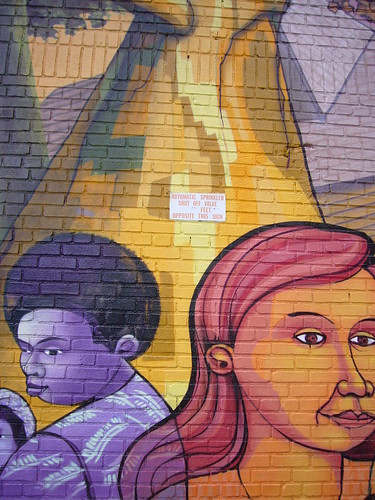 If you're interested in urban exploration literature, you're already aware of Christopher Payne's photography book Asylum: Inside the Closed World of State Mental Hospitals. Released in late September (2009) by The MIT Press, Asylum seemed to attract more publicity due to its inclusion of an Oliver Sacks essay, but Amazon states that it also won the 2010 Ken Book Award presented by the National Alliance on Mental Illness of New York City Metro (NAMI-NYC Metro). For UE literature followers, it seems to be furthering the trend of UE subject-themed works, ie: photos featuring cans containing cremated human remains, gas station photo essays, and online visual encyclopedias of abandoned theaters.
If you're interested in urban exploration literature, you're already aware of Christopher Payne's photography book Asylum: Inside the Closed World of State Mental Hospitals. Released in late September (2009) by The MIT Press, Asylum seemed to attract more publicity due to its inclusion of an Oliver Sacks essay, but Amazon states that it also won the 2010 Ken Book Award presented by the National Alliance on Mental Illness of New York City Metro (NAMI-NYC Metro). For UE literature followers, it seems to be furthering the trend of UE subject-themed works, ie: photos featuring cans containing cremated human remains, gas station photo essays, and online visual encyclopedias of abandoned theaters. Although part of UE photography is undeniably the beauty of ruins, there is a significant benefit derived from these subject-themed works. UE photography is shifting from being viewed as an artistic aesthetic and being used as a historical resource.
These UE subject-themed works are serving as journalism, but one that's aesthetically pleasing. Documenting ruins is now valued on a more mainstream level. Like any other genre of photography, the photographer engages in the activity for a variety of reasons; it might be about the modernist aesthetics to one; the photographic act for another. But documentation of what once was is arguably the most important aspect.
Oliver Sacks addresses this topic in the last, lengthy paragraph of his essay. Most of the essay provides a context only possible with works: the history of lunatic asylums, institutionalization, deinstitutionalization. But in his last paragraph, he states "One must not be too romantic about madness, or the madhouses in which the insane were confined...Payne is a visual poet as as well as an architect in training...His photographs are beautiful images in their own right, and they also pay tribute to a sort of public architecture that no longer exists. They focus both on the monumental and the mundane, the grand facades and the peeling paint."
Payne's essay provides a more specific context for the reader. He spends quite a bit of time explaining "the Kirkbride Plan", illustrating it with a four-part photograph and the floorplan of Massachusetts' Danvers Hospital. (The Kirkbride Plan is a design that was used by many mental hospitals and consists of a central administration building with numerous attached pavilions, built in a V formation.) Paynes' "Afterword" is a more personal recount of his experiences and includes beautiful photos of Danvers' demolition. Within the photos, Payne adds a few words as well; his paragraph about "The Quintessential View" is wonderful.
But what of the photos? As expected, they're provoking, thoughtful, and pleasing. A combination of exterior and interior shots, black & white and color photography, they show both the absence and presence of the patients. The buildings have a physical grandeur and importance that conflicts with their abandonment.
So, Asylum is 2009's UE book of the year, mostly because it is one of the few UE books to get mainstream recognition but also because it sheds light on what UE photography often means to the reader and viewer: an edgy, catchy, easy way to learn our history.
A couple of related links:
The New York Times' David W. Dunlap has a nice summary of the book, along with a slide show.
Amazon is so huge now that it's often accurate in regards to rare, out-of-print books. And the customer reviews are pretty great. This details Payne's previous book.
Sewell Chan's article focuses on Queens' Creedmoor Psychiatric Center.
Payne's photographic series on North Brother Island can be accessed here on his official website.
